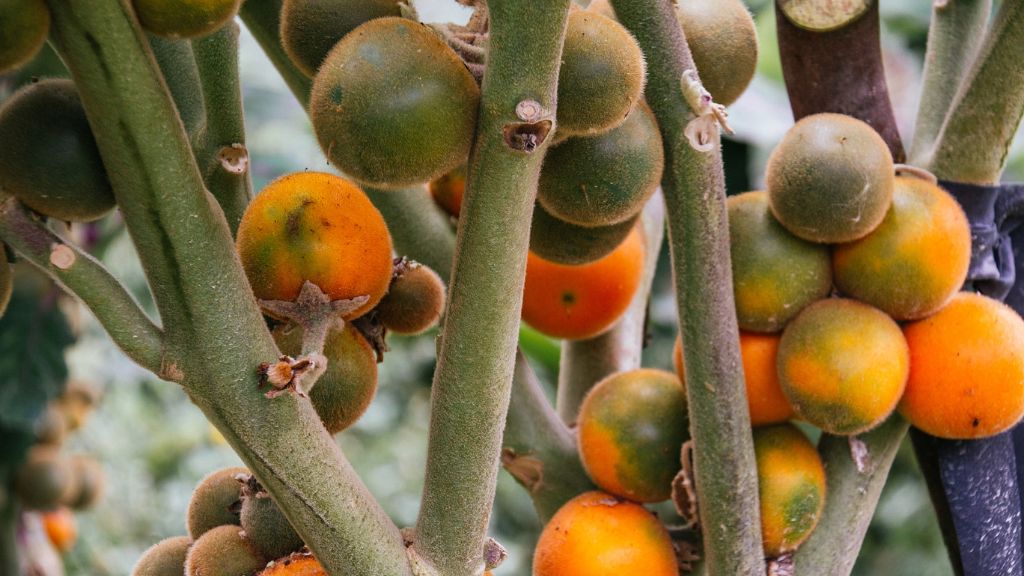Naranjilla Plant Information


It's not a "little orange" as the common name suggests in Spanish. Instead, the naranjilla is a fascinating heirloom plant with fantastic foliage and delicious, citrus-like fruit. Read on for more information about this fruit tree.
History of Naranjilla
The naranjilla (Solanum quitoense) is not in the citrus family. It's a member of the nightshade clan, a botanical cousin of the tomato and eggplant. Native to the mountains of Central and South America, this plant grows abundantly in the wild in Peru, Ecuador and southern Colombia. Both Columbia and Ecuador gifted seeds to the United States in the early 1900s. The shrubs have been cultivated successfully in Florida ever since. Why is this tree named after the orange ("naranja" in Spanish)? Because it produces round, orange fruit that looks like small oranges and taste like a cross between a pineapple and a lemon. They are called naranjillas or lulos, among other common names.
Naranjilla Plant Information
The naranjilla plant is an attractive bush or small tree, growing to 8 feet tall. The "trunk" is a thick stem. It is covered with spines in the wild but many cultivars are spineless. The narajilla blossoms are striking. You'll see five white petals on top with imposing stamen that are marigold yellow. Under these are bright purple petals. The flower's fragrance is appealing as well. Leaves grow in a deep purple. They are heart shaped and grow quite large over the life of the plant"”up to 24 inches long. Their texture is soft and wooly. Most gardeners cultivate the naranjilla plant for its round fruit. The fruit is not large, growing only 2 or 3 inches in diameter. The leathery peel covering each naranjilla turns orange as the fruit matures. Until then, the fruit is covered in thick brown hairs, not unlike kiwi fruit. The fruit flesh is yellowy orange, and contains a ring of juicy pulp dotted with thin seeds.
Naranjilla Growing Conditions
The shrub is found in the semi-tropics at elevations of 3,000 to 8,000 feet. It is picky about temperatures. It thrives where the temperature stays between 62 and 66 degrees Fahrenheit (16-18 C.), and doesn't tolerate temperatures above 85 degrees F. (29 C.). Naranjillas need high humidity to thrive. They do best in semi-shade.
Gardening tips, videos, info and more delivered right to your inbox!
Sign up for the Gardening Know How newsletter today and receive a free copy of our e-book "How to Grow Delicious Tomatoes".

Teo Spengler is a master gardener and a docent at the San Francisco Botanical Garden, where she hosts public tours. She has studied horticulture and written about nature, trees, plants, and gardening for more than two decades. Her extended family includes some 30 houseplants and hundreds of outdoor plants, including 250 trees, which are her main passion. Spengler currently splits her life between San Francisco and the French Basque Country, though she was raised in Alaska, giving her experience of gardening in a range of climates.
-
 Best Indeterminate Tomatoes: Flavor-Packed Varieties For Fresh Harvests All Summer Long
Best Indeterminate Tomatoes: Flavor-Packed Varieties For Fresh Harvests All Summer LongIndeterminate tomatoes are vining varieties that fruit all season. Discover their distinctive features and how to choose the best type to grow in your garden.
By Bonnie L. Grant
-
 The Dangers Of AI For Gardening – How To Know What’s Real When It Comes To Your Garden
The Dangers Of AI For Gardening – How To Know What’s Real When It Comes To Your GardenThings aren’t always what they seem when it comes to using AI for gardening. Be discerning when relying on AI for accuracy, and take the time to do research.
By Teo Spengler